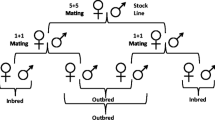Abstract
Drosophila pseudoobscura stocks maintained in laboratory culture for some time had altered mate recognition systems compared with recently collected control stocks. Three showed a significant deviation from random mating; in one, a tendency toward homogametic mating was recorded. Such deviations are in marked contrast to results from populations which have been recently collected from the field. Asymmetrical mating was observed in two of the crosses in the direction predicted by the Kaneshiro model.
Similar content being viewed by others
References
Ahearn, J. N. (1980). Evolution of behavioural reproductive isolation in a laboratory stock ofDrosophila silvestris.Experientia 36:63–64.
Anderson, W. W., and Ehrman, L. (1969). Mating choice in crosses between geographic populations ofDrosophila pseudoobscura.Am. Midland Nat.,81:47–53.
Arita, L. H., and Kaneshiro, K. (1979). Ethological isolation between two stocks ofDrosophila adiastola.Proc. Hawaii Entomol. Soc. 23:31–34.
Bryant, E. H., Kence, A., and Kimball, K. T. (1980). A rare-male advantage in housefly induced by wing clipping and some general considerations forDrosophila.Genetics 96:975–993.
Carson, H. L. (1982). Speciation as a major reorganization of the polygenic balance. In Barigizzi, C. (ed.),Mechanism of Speciation, Alan R. Liss, New York, pp. 411–433.
Charlesworth, B., Lande, R., and Slatkin, M. (1982). A neo-darwinian commentary on macroevolution.Evolution 36(3):474–498.
Del Solar, E. (1966). Sexual isolation caused by selection for positive and negative phototaxis and geotaxis inDrosophila pseudoobscura.Proc. Natl. Acad. Sci.,56:484–487.
Dobzhansky, Th. (1963). Species inDrosophila.Proc. Linn. Soc. Lond.,174:1–12.
Eoff, M. (1973). The effect of being cultured together on hybridization betweenDrosophila melanogaster andDrosophila simulans.Am. Nat. 107:247–255.
Giddings, L. V., and Templeton, A. R. (1983). Behavioral phylogenies and the direction of evolution.Science 220:372–378.
Goodwin, B. C. (1979). On morphogenetic fields.Theoria Theory 13:109–114.
Goux, J. M., and Anxolabehere, D. (1980). The measurement of sexual isolation and selection: A critique.Heredity 45:255–262.
Hailman, J. P. (1975).Optical Signals: Animal Communication and Light, Indiana University Press, Bloomington.
Henderson, N. R., and Lambert, D. M. (1982). No significant deviation from random mating of world wide populations ofDrosophila melanogaster.Nature 300:437–440.
Kaneshiro, K. Y. (1976). Ethological isolation and phylogeny in thePlanitibia subgroup of HawaiianDrosophila.Evolution 30:740–745.
Kaneshiro, K. Y., (1980). Sexual isolation, speciation and the direction of evolution.Evolution 34:437–444.
Kaneshiro, K. Y. (1983). Sexual selection and direction of evolution in the biosystematics of HawaiianDrosophila.Annu. Rev. Entomol. 28:161–178.
Lambert, D. M. (1984). Specific-mate recognition systems, phylogenies and asymmetrical evolution.J. Theoret. Biol. 109:147–156.
Lambert, D. M., and Hughes, T. (1984). The misery of functionalism.Riv. Biol. 77:477–501.
Lambert, D. M., and Paterson, H. E. H. (1984). On bridging the gap between race and species: The isolation concept and an alternative.Biol. J. Linn. Soc. NSW 107:501–514.
Lambert, D. M., Kingett, P. D., and Slooten, E. (1982). Intersexual selection: The problem and a discussion of the evidence.Evol. Theory 6:67–78.
Lambert, D. M., Spencer, H. G., and Millar, C. D. (1985). What Kaneshiro “really said” about asymmetrical mating.Evol. Theory 7:165–167.
Løvtrup, S. (1974).Epigenetics: A Treatise on Theoretical Biology, John Wiley and Sons, New York.
Mayr, E., and Dobzhansky, Th. (1945). Experiments on sexual isolation inDrosophila. IV. Modification of the degree of isolation betweenD. pseudoobscura andD. persimilis and of sexual preferences inD. proaltans.Proc. Natl. Acad. Sci. 31:75–82.
Millar, C. D. and Lambert, D. M. (1985). The mating behaviour of individuals ofDrosophila pseudoobscura from New Zealand,Experientia 41:950–952.
Paterson, H. E. H. (1980). A comment on mate recognition systems.Evolution 34:330–331.
Paterson, H. E. H. (1981). The continuing search for the unknown and unknowable: A critique of contemporary ideas on speciation.Sth. Afr. J. Sci.,77:113–119.
Powell, J. R. (1978). The founder-flush speciation theory: An experimental approach.Evolution 32:465–474.
Powell, J. R., and Morton, L. (1979). Inbreeding and the mating patterns inDrosophila pseudoobscura.Behav. Genet.,9:425–429.
Prakash, S. (1972). Origin of reproductive isolation in the absence of apparent genetic differentiation in a geographic isolate ofDrosophila pseudoobscura.Genetics 72:143–155.
Rachootin, S. P., and Thomson, K. S. (1981). Epigenetics, palaeontology and evolution. In Scudder, G. G. E., and Reveal, J. L. (eds.),Evolution Today, Proceedings of the Second International Congress of Systematics and Evolutionary Biology, Carnege-Mellon University, Pittsburgh.
Sonneborn, T. M. (1970). Gene action in development.Proc. Roy. Soc. Lond. B. 176:347–366.
Spiess, E. B. (1968). Courtship and mating time inDrosophila pseudoobscura.Anim. Behav. 16:470–479.
Tan, C. C. (1946). Genetics of sexual isolation betweenDrosophila pseudoobscura andDrosophila persimilis.Genetics,31:558–578.
Watanabe, T. K., and Kawanishi, M. (1979). Mating preferences and the direction of evolution inDrosophila.Science 205:906–907.
Webster, G., and Goodwin, B. C. (1982) The origin of species: A structuralist approach.J. Soc. Biol. Struct. 5:15–47.
Weiss, P. A. (1971).Within the Gates of Science and Beyond: Science and Its Cultural Commitments, Hafner, New York.
Author information
Authors and Affiliations
Additional information
This research is supported by New Zealand University Grants Committee Grant 141Z164/D. M. Lambert. The authors with to thank L. Barr, D. F. Poulson, A. Beckenach, R. A. Norman, and B. C. Moore for their kind assistance in sending us cultures.
This contribution represents publication No. 12 from the Evolutionary Genetics Laboratory, University of Auckland.
Rights and permissions
About this article
Cite this article
Millar, C.D., Lambert, D.M. Laboratory-induced changes in the mate recognition system ofDrosophila pseudoobscura . Behav Genet 16, 285–294 (1986). https://doi.org/10.1007/BF01070804
Received:
Accepted:
Issue Date:
DOI: https://doi.org/10.1007/BF01070804




